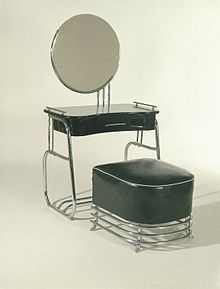Kem Weber
Graduating in 1912, Weber went on to work in Paul's office, having previously assisted his tutor in the design of the German pavilion at the 1910 'Exposition Universalle' in Brussels.
Paul sent his assistant to San Francisco, California, to supervise work on the German pavilion being built for the Panama-Pacific International Exposition of 1915.
Seeing greater opportunity in the New World, Weber stayed in the United States after the war ended, later becoming a U. S. citizen in 1924, anticipating later European talents such as Ludwig Mies van der Rohe, Marcel Breuer and the Hoffmanns.
The inclusion of his work in the 1928 'International Exposition of Art in Industry' held by New York store Macy's cemented his reputation and he went on to design many products for a wide variety of companies including Widdicomb, Berley & Gay, Friedman Silver and Lawson Time.
Weber's most famous work is probably the "Airline" chair of 1934, which exemplified the clean, streamlined style of the age, with its seat supported by a cantilevered frame reminiscent of wooden aircraft components.



